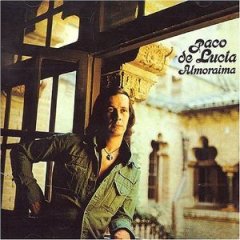Paco De Lucia – Almoraima (1976)
Paco De Lucia – Almoraima (1976)

1. Almoraima
2. Cueva del Gato
3. Cobre
4. A l Perla de Cadiz
5. Ole
6. Plaza Alta
7. Río Ancho
8. Llanos del Real
Musicians Paco de Lucía - Flamenco guitar Ramón de Algeciras - Flamenco guitar Alvaro Yebenes - Bass Guitar Jose Torregrosa - Arrangements and Musical Direction Pedro Ruy-Blas - Percussion
By 1976, the face of Spain had changed considerably. The death of Franco had opened up a new period marked by the coming of a democratic system that would eventually play an important role in the lives of artists. Television was still seen in black and white in most homes. Blue jeans suddenly appeared, becoming so fashionable that King Juan Carlos I, still unaccustomed to his monarchical duties, was seen in public with the revolutionary new fashion. The ruling party was moderate, paving the way for the passing of power from right to left. Carrillo and Isidoro had returned from exile. The latter made the corduroy jacket fashionable, which was renamed the "Felipe".
Meanwhile, in the world of flamenco, a gitano from San Fernando was becoming known after making a name for himself in the Madrid tablao Torres Bermejas. Camarón was the symbol of the new times. At that moment, there were several other acknowledged young artists, such as the restless Enrique Morente, who had caused a commotion in Madrid with his flamenco; Juan Peña el Lebrijano; José Menese; and El Cabrero, who could finally sing his lyrics without being arrested by the Guardia Civil.
But the first one to breathe in this new air of liberty was a young twenty-nine-year old man from Algeciras, photographed in the nearby ranch of "La Almoraima" with a bushy head of "Liverpool fashion" hair and an unbuttoned khaki jacket revealing a hippie-style necklace. Francisco Sánchez, known to all as Paco, el hijo de Luzía la portuguesa, had abandoned the austerity seen on the cover of such important albums as "La fabulosa guitarra de Paco de Lucía". Perhaps this was the result of those repressive times, or maybe it was due to his own aspiration to strike a road apart from his maestros the day that he could also be considered as such.
The first of his mentors, Manuel Serrapí -Niño Ricardo-, had already disappeared from the stage, his transcendental voice cut short by his illness and eventual death.
Sabicas -don Agustín-, his second mentor, had settled in New York by that time, but from that moment until his death in 1990 he constantly acknowledged Paco's skill, to the point that he regretted having criticized him for being so innovative.
It was time for him to fly alone. In the wake of the great success of "Fuente y Caudal" at the beginning of the decade, his followers were expecting another sensational release. In this climate, "Almoraima" was born: an unquestionably revolutionary recording for the world of flamenco guitar, but one that does no more than progress in the schools of the two aforementioned geniuses. Paco, of course, took their teachings to greater heights. This recording was a turning point in the career of Paco, and, by extension, in flamenco.
Before proceeding to a detailed analysis of the recording, it should be pointed out that the maestro was aware of all that was happening in flamenco. He had already recorded with Fosforito, el Lebrijano, el Sevillano and, of course, Camarón. But he was also familiar with the work of groups like Smash or Gong. ---flamenco-world.com
download: uploaded yandex 4shared mediafire solidfiles mega filecloudio nornar ziddu
Last Updated (Thursday, 27 February 2014 16:10)








